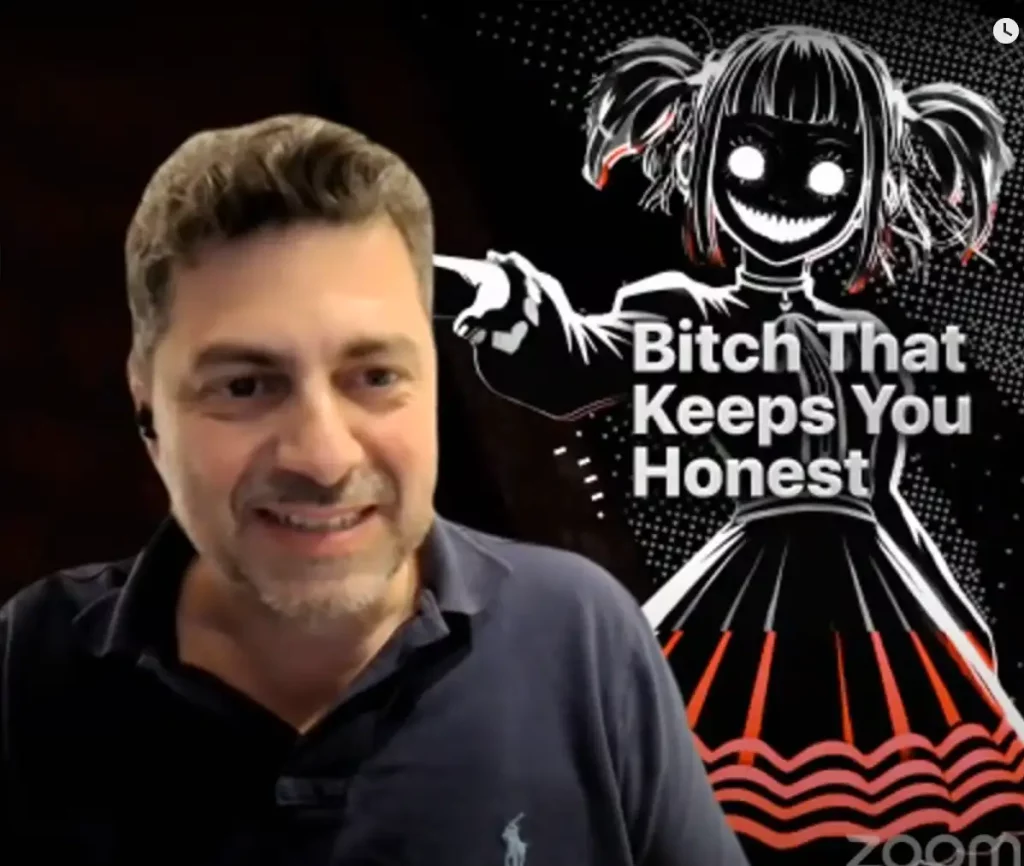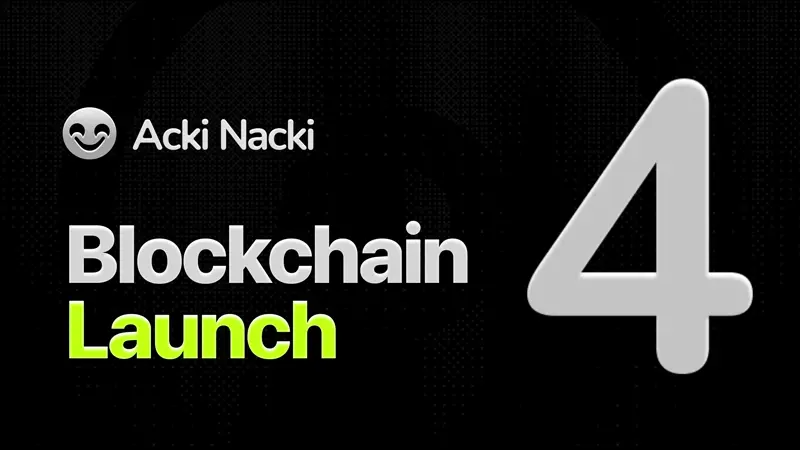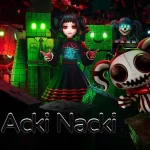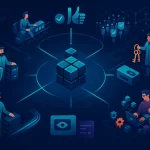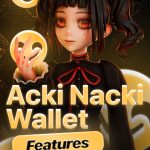We got invited to a livestream with Mitja Goroshevsky, the co-founder of GOSH, and the mad genius behind Acki Nacki. What was the plan? No plan. Just a bunch of sharp questions, one black screen, and a freefall into the weird and wild corners of blockchain’s next evolution.
From gameplay-as-mining and probabilistic consensus, to building AI personas and redefining what “proof” even means — nothing was sacred, everything was on the table. This wasn’t a sales pitch. It was raw, technical, unpredictable, and yes — very human.
We didn’t follow the flow. The flow dragged us in. And somehow, it worked.
NOTE: Full MP3 audio of the livestream is available. There’s also a YouTube video version… kinda. Technically. Dapp Whisperer was supposed to show up with a camera and lighting. Instead? A black void. Classic Dapp move.
⚡️ TL;DR – Dapp Whisperer x Mitja Livestream Recap
In a no-script, high-signal livestream, Dapp Whisperer joined Mitja Goroshevsky (GOSH co-founder, Acki Nacki creator) to explore the tech, philosophy, and direction of the Acki Nacki blockchain. Here’s what went down:
🧱 Acki Nacki is a new kind of L1
Designed from scratch, it introduces a probabilistic consensus model: fixed block producers + randomly chosen verifiers (Ackis/Nackis). This reduces message complexity and allows near-instant finality. The system is mathematically resistant even with up to 49% malicious and 49% DDoS-attacked nodes.
🎮 Popit Game = Proof-of-Human
More than a game, Popit serves as a human-centric consensus tool. Real players verify blocks through play — not bots. This creates emotional ownership of tokens and makes participation fun, meaningful, and secure. Future apps may include journalism, writing, or even content engagement.
🪙 Two-token model done right
-
NACKL: deflationary value token, staked for security.
-
SHELL: utility token for fees, designed to stay cheap.
This separation solves the single-token paradox where high value breaks usability. NACKL grows; SHELL stays low. Devs win. Users win.
🧠 AI meets memory meets blockchain
Dapp Whisperer is training a personal AI on his lifetime of writing and Acki Nacki data — a “digital twin” that will eventually live on-chain. Mitja emphasized that decentralization is essential for AI — to prevent a future dominated by 5 tech companies.
🚀 Launch timeline
-
Testnet (pre-net): days away.
-
Wallet + mining app: going live together.
-
Apple delisted the game. Working on new dev account and wallet app for iOS. Mining on Steam os no. Android and web version is a go.
-
Merged apps and full in-game mining will follow soon.
🧪 Not just another chain
Built by a 13-person engineering team, Acki Nacki is stress-tested daily with extreme TPS and attack simulations. A documentary is being filmed to show the process. Think Formula 1 meets blockchain R&D.
🧭 Philosophy: Decentralization = Truth
Acki Nacki isn’t here to dominate. It’s here to make truth uncensorable, AI accountable, and digital interaction valuable. It’s not about hype — it’s about building infrastructure for the next internet.
Here we go…
Mitja: Welcome everyone. Today we have a stream with Tomislav, aka Dapp Whisperer. He’s prepared some tough questions. We decided to keep it spontaneous and creative. Normally I play the game during the stream, but I couldn’t set everything up because I’m traveling. We opted for this interview format instead. Also, I received 28 questions today, so there wouldn’t be any time left for gameplay. Thanks again to everyone joining, and thank you, Tom, for being here.
Dapp: You’re welcome. And yes, I’m the “black screen” today, didn’t prep my camera. I thought you’d be gaming while we chatted casually. But let’s dive in. I’d like to start with an announcement. Actually, it’s more of a reveal. I’m presenting the first public version of my web portal: DappAhoy.com. It’s fully dedicated to Acki Nacki and the ecosystem that will grow around it. You’ll find updates, insights, and everything happening on-chain. The site is still under development since it’s a side project, but I’m spending more and more time on Acki Nacki. Eventually, I hope it becomes my full-time work (aside from Popit Games, of course).
It’s not just me working on this. I trained a large language model, a personal AI agent as part of a larger project. It’s been fed with everything I could find on Acki Nacki: official documents, Telegram chats, tweets, news, and more. It learns daily from new announcements, and I fact-check its output. If this ever becomes public, it could serve as a full Acki Nacki knowledge base.
The AI also reflects my personal style. I trained it with over a thousand blog posts, articles, and forum replies I’ve written throughout my life. It knows how I think, how I write, and how I speak. I even invited the community to help refine it by pointing out errors. I make sure it doesn’t spread misinformation.
Mitja: That’s amazing. Really impressive.
Dapp: Thanks. It learns every day. Honestly, I don’t know where this ends.
Mitja: Which model are you using?
Dapp: For the public-facing version, it’s ChatGPT. But I’m also building a custom version based on LLaMA with help from a friend. He’s guiding me on what’s best for this kind of project.
Mitja: There are some interesting new Chinese models too. And DeepSeek…
Dapp: Yeah, DeepSeek has a model too, though I don’t know its name.
LLaMA is everywhere, and I hope it will serve the purpose. The core of the project is still in development. My goal is to create a digital clone of myself — a kind of AI persona built from all my memories, my friends’ and family’s perspectives, and my writings. When I die, I want my grandchildren to talk to me in some VR space, not just look at a photo.
Mitja: Who knows, in 10 or 20 years we might all upload ourselves into AI.
Dapp: Exactly. And once the tech is ready, I want this to live on the blockchain. Like Popit Games and Popcoins are minted, I want each article to be minted as a smart contract, permanent and immutable.
Mitja: That’s closer than you think. At GOSH, we built tools for putting Git on-chain. After we launch, uploading content to the blockchain will be standard. AI needs blockchain. Otherwise, we risk it being monopolized by just a few companies.
Dapp: I agree. Hardware isn’t even the main bottleneck, it’s control.
Mitja: Right. GPUs are getting cheaper. Within a few years, everyone will be able to afford training large models. The real challenge is decentralizing control. AI is the most powerful tool humanity has ever created. It must not be controlled by a handful of corporations or governments.
When people talk about AI privacy risks, I believe the bigger issue is openness. Just like how everyone can trace crypto transactions, we should make AI prompts public on-chain. It’s the best protection against malicious use.
Dapp: But what about teaching the AI?
Mitja: Teaching isn’t the problem. Inception is. Teaching requires expertise. Not everyone can fine-tune models properly. But as long as the base model is open-source, the rest is manageable. Open models will catch up in a year or two.
Dapp: Great. So, let’s return to Acki Nacki. I structured these questions to understand your journey better. Why did I even get into Acki Nacki a year ago? You were CTO at TON Labs, co-founded GOSH, and now Acki Nacki. What led to this new chain?
Mitja: It’s a natural progression. Back at TON Labs and even before that on Ethereum, we realized you couldn’t build user-facing apps that were fast enough. Everything ended up on private chains. Public chains were too slow. That was years ago, and the situation still hasn’t changed much.
Ethereum wasn’t fast or scalable enough. TON was better, and we did a lot there, rewriting the protocol in Rust, building infrastructure, compilers, etc. But even then, with 10-second finality, it wasn’t good enough for large-scale use. Solana had a promising design, but it also hit scaling limits.
So I asked myself: can we build something better? That’s where Acki Nacki came from.
Dapp: I saw on LinkedIn that you authored the consensus protocol. So this is the logical next step?
Mitja: Yes. The fundamental issue is message complexity. How many messages are exchanged to finalize a block? That defines the speed. Most existing protocols couldn’t deliver what I envisioned, so I had to design my own.
Dapp: Let’s talk about the technology behind Acki Nacki. You’ve introduced block producers, verifier managers, and mobile nodes. Was this architecture inspired by other systems, or is it something completely new and experimental? It feels like you’re building a living network, a digital organism.
Mitja: In every network, someone needs to produce blocks, that’s fundamental. But how block producers are chosen varies greatly. Many protocols rely on rotating block producers frequently for security. However, that rotation requires a lot of messaging and agreement overhead, which wastes time and resources. Random selection also requires distributed randomness, which itself is complex and inefficient.
So I thought, what if we don’t rotate block producers unless they go offline? What if we just keep them in place? That’s the first design decision in Acki Nacki: assume the block producer can be malicious, and build around that.
Instead of rotating producers, we randomly choose verifiers, what we call Ackis or Nackis. That’s the core innovation. The block producer never knows which node will verify its block. This unpredictability makes attacks statistically unprofitable. Even if 49% of the network is malicious and another 49% is being DDoSed, the remaining 1% of honest nodes can still finalize blocks. It’s probabilistic security by design.
Dapp: That’s a clever approach. Let’s shift to Popit Game. It’s a rogue-like on-chain tag/sabotage game. Why is it so closely tied to the Acki Nacki ecosystem? It doesn’t feel like just a side project.
Mitja: The game itself isn’t core, but the verification mechanism it demonstrates is. You could verify identity or participation with a black screen and a finger swipe, sure. But it would be boring, and people would cheat by automating the interaction.
We needed something fun, human, and verifiable. A game was the natural answer. The game incentivizes real people to interact, click, drag, draw, and participate in consensus through physical engagement. That makes the token they earn feel earned, not extracted by some electronic bot.
Dapp: So, mining through gameplay makes users feel like stakeholders in consensus, not just spectators?
Mitja: Exactly. They don’t need to understand consensus mechanisms. They just play, engage, and earn. Whether it’s games, content creation, image editing, or blogging, any interaction with the screen can be rewarded. We’ve built a proof-of-interaction system.
Dapp: Even writing blog posts on-chain could mine NACKL?
Mitja: Yes. Touching the screen, typing, creating content, voting, interacting, it all counts. Imagine an article embedded with interactive polls, buttons, or mintable elements. Readers interacting with it are also mining. It’s like turning content into a mining engine.
Dapp: That completely redefines how value is created. Like a social network where every action matters.
Mitja: Yes. Like crypto Instagram, but you mine while engaging. It’s open to anyone. Developers can integrate the mining SDK into their apps and tie engagement directly to consensus.
Dapp: So mining isn’t exclusive to gaming. It could extend to writing, art, journalism…
Mitja: Correct. We’ve even talked with journalists about proof-of-journalism systems, rewarding evidence-based content creation. Any meaningful screen interaction becomes part of network security.
Dapp: What about platform support? We heard Apple delisted the game. Was that a test or a stunt?
Mitja: It was a real test, and a marketing push. We wanted feedback. It was important for learning. Sadly, Apple removed it without clear reason, even the developer account got deleted. That’s rare. There’s no blockchain in the app yet, so we don’t understand their reasoning.
Dapp: What now for iOS?
Mitja: We’re cautiously optimistic. We’re preparing a separate build for iOS, first via a different dev account in public beta. If Apple approves the wallet, we’re good. The wallet is essential, without it, we don’t know where to send mined NACKL.
Dapp: So the initial release includes a wallet app and a mining-enabled app?
Mitja: Yes. On Android and web, mining happens through minting Popits. To earn NACKL, users need to install the wallet and link it. The mobile game will integrate mining later. Initially, only minting Popits will mine.
Dapp: Understood. The million NACKL tournament, is it fair to say it was both a test and a marketing campaign?
Mitja: Mostly marketing, yes. But also a test. We wanted to see how people interact with the game. Feedback helps. Some users got stuck at early levels, which surprised us. But it made us realize we could actually help people learn math.
Dapp: So there’s an educational layer too?
Mitja: Absolutely. If thousands of users reach level 10 after struggling at level 5, they’ve effectively learned primary school math. If we help improve numeracy at scale, that’s already a huge win, even beyond blockchain.
Dapp: I see it with my own son. He avoids doing math manually. Everything is a calculator now.
Mitja: Calculators are fine, if you know how to use them. Many people don’t even grasp basic arithmetic. If our game nudges them toward learning, we’ve accomplished something big.
Dapp: Let’s shift to tokenomics. Acki Nacki has a dual-token system: a finite NACKL and an infinite SHELL. What’s the logic behind that?
Mitja: In most blockchains, a single native token is used both to secure the network and pay fees. But these roles have opposite incentives. For security, you want the token’s value to increase, higher stakes mean stronger protection. But for fees, you want stability or even deflation, so developers and users aren’t priced out.
Ethereum tried to do both with one token. When ETH rises, network security improves, but gas fees spike. That’s why Layer 2s became necessary. Solana tried to keep fees low but still faces scaling issues. We decided to separate concerns.
NACKL is for value and staking. It’s deflationary, mimics Bitcoin’s minting curve, and should grow in value. SHELL is the utility token, used for transaction fees, and designed to remain stable or even decrease slightly over time. This makes it sustainable for developers.
Dapp: So the two tokens live separate lives.
Mitja: Exactly. We divorced them. NACKL secures. SHELL powers usage. This avoids the contradictory tension found in single-token systems.
Dapp: Let’s fast forward. Where do you see Acki Nacki in five years?
Mitja: Honestly, even two weeks from now is hard to predict. We’re building something from scratch, millions of lines of code. Writing a new blockchain is like writing a novel with no end in sight. You can estimate short segments, but the full picture? No way.
Dapp: That’s what many users don’t get. They ask for launch dates or price predictions like it’s flipping a switch.
Mitja: Exactly. Even Elon Musk misses deadlines, and he has massive teams. We work with a small core: about 13 engineers total, including DevOps and testers. Just 10 people actively writing the protocol. There are no weekends, no holidays, just focused work.
Dapp: That’s full dedication.
Mitja: It has to be. We’re pushing to the edge. Acki Nacki isn’t just another blockchain, it’s designed to be the fastest possible. Every day we stress test it with thousands of transactions per second. We break it, fix it, and push further.
We’re also releasing a documentary to show how this compares to designing a Formula 1 car, constant iteration, edge-case testing, and tuning under pressure. Most chains cap at 3,000 TPS. We aim far beyond that, with a probabilistic security model and essentially limitless scalability.
Dapp: And spam attacks?
Mitja: With free gas, we expect spam. But we design for it. We assume abuse will happen. If we can hit a million transactions per second, spamming becomes economically unviable, even free spam has a cost in scale.
Dapp: If this vision works, what becomes obsolete?
Mitja: Potentially everything. But not out of malice, we’re not trying to kill other platforms. It’s not about domination. Acki Nacki exists to offer a decentralized, honest, and human-centric system. It’s about building a collective infrastructure where truth and participation matter.
Dapp: So what’s the core philosophy users should take into their lives from Acki Nacki?
Mitja: Decentralization equals honesty. A blockchain is a timestamped ledger of truth. Once it’s there, it’s immutable. That’s the power of decentralization, no central actor can alter the record. Truth must not be owned. That’s what makes blockchain, and especially Acki Nacki, important.
Dapp: You’re saying truth lives in the collective?
Mitja: Yes. Not in any one person or company, but in a distributed, verifiable system. That’s also critical for AI. We can’t let a handful of corporations shape reality through AI. Blockchain ensures openness and accountability.
Dapp: Let’s wrap with the ultimate question: When mainnet?
Mitja: The classic question. We’re close. The last piece, validator delegation, turned out to be more complex than expected. It’s deeply tied to the core mint logic. So we had to rewrite smart contracts and redo calculations.
We’re finalizing tests and formal verifications now. Testnet, what we call pre-net, should go live in days, not weeks. Wallet and mining apps will launch together. Users will see test NACKLs flowing into wallets and can try out mining.
Dapp: So we’ll eventually have one unified app for wallet and mining?
Mitja: Correct. During testing, they’ll be separate. Once everything checks out, we’ll merge them into a single app.
Dapp: Excellent. Thanks a lot for your time.
Mitja: Thank you. Always a pleasure.
